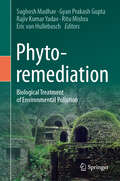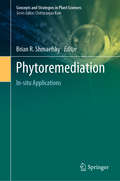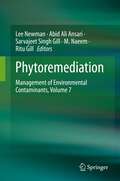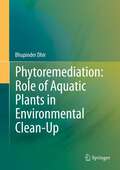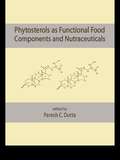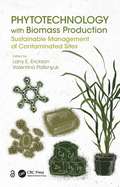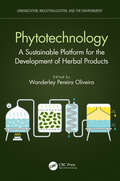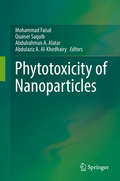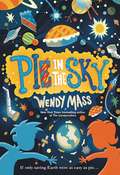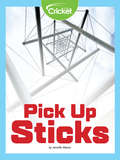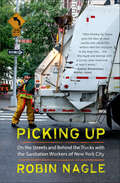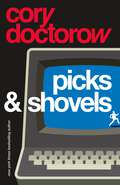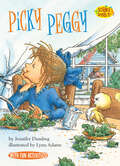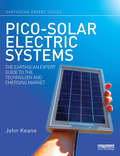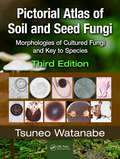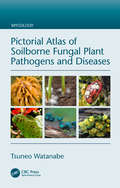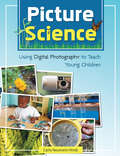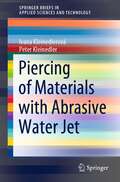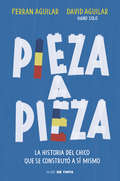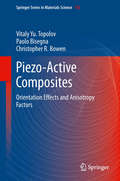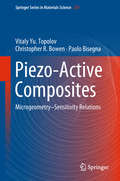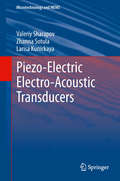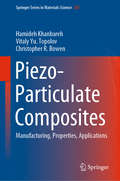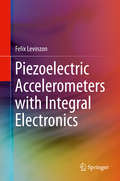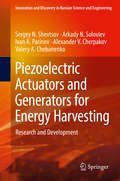- Table View
- List View
Phytoremediation: Biological Treatment of Environmental Pollution
by Sughosh Madhav Eric Van Hullebusch Gyan Prakash Gupta Rajiv Kumar Yadav Ritu MishraThis book covers the fundamentals, limitations, and challenges of phytoremediation in contaminated water, air, and soil due to rapid demographic and industrial development. This foundational knowledge is necessary to combat negative impacts on human and environmental health brought on by practices such as ore mining, gas emission, pesticide application, and municipal waste generation. The book explains the phytoremediation of organic and inorganic pollutants via different types of microbes, fungi, and various plant groups to improve the quality of contaminated systems, and discusses emerging advancements and technologies, such as nanotechnology, for reducing toxic pollution. The mechanisms of phytoremediation are a primary point of focus to understand the basics, and for readers to apply this knowledge in a variety of contexts where phytoremediation is a useful tool in improving the quality of polluted water, air, and soil. The book is mainly intended for researchers in the fields of botany, agriculture, biotechnology, and environmental engineering, but will also be of interest to policymakers, NGOs, and academics working on environmental management.
Phytoremediation: In-situ Applications (Concepts and Strategies in Plant Sciences)
by Brian R. ShmaefskyThis book provides in-situ phytoremediation strategies that are particularly well suited for developing nations. Its goal is to promote the use of field-tested phytoremediation methods for removing soil and water pollutants from agricultural, industrial, military, and municipal sources. These strategies include using algae and a variety of aquatic and terrestrial plants. The book subsequently discusses the use of crops and native plants for phytoremediation, and how phytoremediation efforts impact the rhizosphere. After having finished the book, readers will be able to directly adapt the strategies described here for their specific purposes.
Phytoremediation: Management of Environmental Contaminants, Volume 7
by Sarvajeet Singh Gill Ritu Gill M. Naeem Abid Ali Ansari Lee NewmanThe accumulation of large amounts of contaminants occurs in the environment due to industrialization and various other anthropogenic activities. Contaminants ultimately affect human health worldwide. Organic, inorganic, and radioactive substances are the prevalent forms of environmental contaminants and their complete remediation in soils and sediments is rather a difficult task. Concerns of their toxicities led to the emphasis on development of effective techniques to assess the presence and mobility of contaminants in air, water, and soil. Furthermore, the ever-increasing concentration of toxic pollutants in the environment is considered a serious threat to plant, animal, human, and environmental health.Many technologies are in use to clean and eliminate hazardous contaminants from the environment; however, these technologies can be costly, labor intensive, and often distressing to the general public. Phytoremediation is a simple, cost effective, environmentally friendly and fast-emerging new technology for eliminating toxic contaminants from different environments. Phytoremediation refers to the natural ability of certain plants and their associated microbiome (including hyper-accumulators or bio-accumulators) to remove, degrade, or render contaminants harmless. Through this technique, certain species of plants flourish by accumulating contaminants present in the environment. The unique and selective uptake capabilities of plant root and shoot systems, effective translocation, bioaccumulation, and contaminant degradation capabilities of the accumulator plants are utilized in phytoremediation techniques. Phytotechnologies involving the use of plants for contaminant removal gained importance during the last two decades and phytoremediation technology became an effective tool for environmental detoxification because of plants ability to accumulate the contaminants at very high concentrations.Phytoremediation strategies can remove, degrade, or stabilize inorganic and organic contaminants entering a multitude of ecosystems using green plants and their associated microbial communities. The development and use of phytotechnologies continues to move forward at a steady pace. Researchers recognize the potential of phytoremediation to offer a green, cost effective, eco-friendly and feasible application to address some of the world’s many environmental challenges. This book provides significant information to add to the previous volumes published on the topic and can serve as the foundation for the development of new applications that feature the integration of modern research discoveries into new methods to remediate contaminated ecosystems. Moreover, this volume brings recent and established knowledge on different aspects of phytoremediation and nano-phytoremediation, providing this information in a single source that offers a cutting-edge synthesis of scientific and experiential knowledge on polluted environments that is useful for policy makers, practitioners and scientists, and engineers.Phytoremediation: Management of Environmental Contaminants, Volume 7 highlights the various prospects that are involved in current global phytoremediation research. This book delivers a content-rich source to the reader and can act as a platform for further research studies. It should meet the needs of all researchers working in, or have an interest in this particular field.
Phytoremediation: Role of Aquatic Plants in Environmental Clean-Up
by Bhupinder DhirContamination of the different components of environment through industrial and anthropogenic activities have guided new eras of research. This has lead to development of strategies/methodologies to curtail/minimize environmental contamination. Research studies conducted all over the globe established that bioremediation play a promising role in minimizing environmental contamination. In the last decade, phytoremediation studies have been conducted on a vast scale. Initial research in this scenario focused on screening terrestrial plant species that remove contaminants from soil and air. Later, scientific community realized that water is a basic necessity for sustaining life on earth and quality of which is getting deteriorated day by day. This initiated studies on phytoremediation using aquatic plants. Role of aquatic plant species in cleaning water bodies was also explored. Many of the aquatic plant species showed potential to treat domestic, municipal and industrial wastewaters and hence their use in constructed wetlands for treating wastewaters was emphasized. The present book contains five chapters. First two chapters provide information about types of contaminants commonly reported in wastewaters and enlists some important and well studied aquatic plant species known for their potential to remove various contaminants from wastewater. Subsequent chapters deal with mechanisms involved in contaminant removal by aquatic plant species, and also provide detailed information about role of aquatic plant species in wetlands. Potential of constructed wetlands in cleaning domestic and industrial wastewaters has also been discussed in detail. The strategy for enhancing phytoremediation capacity of plants by different means and effectiveness of phytoremediation technology in terms of monitory benefits has been discussed in last chapter. Last chapter also emphasizes the future aspects of this technology.
Phytosterols as Functional Food Components and Nutraceuticals (Nutraceutical Science And Technology Ser. #Vol. 1)
by Paresh C. DuttaAnalyzes food and biological samples of phytosterols and discusses plant sterol analysis with respect to functional foods. Investigates the safety of phytosterols and phytosterol esters and associated health risks, including potential impact on cancer development and the lowering of cholesterol levels. Details the chemistry, occurrence, and biological effects of phytosterol oxides.
Phytotechnology with Biomass Production: Sustainable Management of Contaminated Sites
by Larry E. Erickson Valentina PidlisnyukThis book explains the concept of using phytotechnology with biomass production to improve soil quality and restore contaminated sites to a useful state that has economic and social value. Phytotechnology with Biomass Production: Sustainable Management of Contaminated Sites focuses on the application of second-generation biofuel crops, primarily Miscanthus, to slightly contaminated or marginal postmilitary and postmining soils. Based on recent and ongoing research from the United States, Ukraine, the Czech Republic, and Germany, along with case studies from other countries, this is the first comprehensive book on using phytotechnology with biomass production at contaminated sites at a global level. FEATURES Focuses on an important topic of a growing global activity: soil improvement through biomass production Includes case studies and success stories from different countries on application of Miscanthus phytotechnology to sites differently contaminated by trace elements, pesticides, and petroleum products Discusses the peculiarities of Miscanthus production on postmilitary and postmining contaminated lands and the impact of plant growth regulators, soil amendments, fertilizers, and biochar to the process Introduces soil fauna as indicators of soil health during Miscanthus phytotechnology application Presents Miscanthus value chain associated with the processing of Miscanthus biomass to different bioproducts While written primarily for faculty, students, research scientists, environmental and agricultural professionals, gardeners, farmers, landowners, and government officials, this book has value for all who are working on phytotechnology projects and phytomining to reduce risk and/or improve soil quality at contaminated sites. Phytotechnology with Biomass Production: Sustainable Management of Contaminated Sites is also a great new resource for those who are new to the topic and want to learn to apply phytotechnologies and biomass production with further conversion into energy and bioproducts.
Phytotechnology: A Sustainable Platform for the Development of Herbal Products (Urbanization, Industrialization, and the Environment)
by Wanderley Pereira OliveiraHerbal products have traditionally been used in several industrial sectors and have gained a notable reputation in recent years due to the current trend in society, which seeks natural, healthier, and more sustainable products. The processing of these products, however, is multiplex but important for the production of a high-quality standardised product. Phytotechnology: A Sustainable Platform for the Development of Herbal Products highlights the complex, multidisciplinary process of phytopharmaceutical technology used to create herbal remedies. Organised into four parts, various experts in the field clearly and objectively address the fundamental and technological concepts involved in the manufacturing of high-quality herbal products. Additional Features Emphasises how herbal products have traditionally been used in several industrial sectors, including pharmaceutical science, food, cosmetics, chemical engineering, and agroindustry Provides a much-needed update of the current information regarding phytopharmaceutical technology and focuses on industrial applications Written using a multidisciplinary approach, to include all subjects involved in the processing of herbal products The information presented is valuable reference material for professionals of different specialties who wish to enter this fascinating and innovative area.
Phytotoxicity of Nanoparticles
by Quaiser Saquib Mohammad Faisal Abdulaziz A. Al-Khedhairy Abdulrahman A. AlatarThis book provides relevant findings on nanoparticles’ toxicity, their uptake, translocation and mechanisms of interaction with plants at cellular and sub-cellular level. The small size and large specific surface area of nanoparticles endow them with high chemical reactivity and intrinsic toxicity. Such unique physicochemical properties draw global attention of scientists to study potential risks and adverse effects of nanoparticles in the environment. Their toxicity has pronounced effects and consequences for plants and ultimately the whole ecosystem. Plants growing in nanomaterials-polluted sites may exhibit altered metabolism, growth reduction, and lower biomass production. Nanoparticles can adhere to plant roots and exert physicochemical toxicity and subsequently cell death in plants. On the other hand, plants have developed various defense mechanisms against this induced toxicity. This books discusses recent findings as well as several unresolved issues and challenges regarding the interaction and biological effects of nanoparticles. Only detailed studies of these processes and mechanisms will allow researchers to understand the complex plant-nanomaterial interactions.
Pi in the Sky
by Wendy MassJoss is the seventh son of the Supreme Overlord of the Universe, and all he gets to do is deliver pies. That's right: pies. Of course these pies actually hold the secrets of the universe between their buttery crusts, but they're still pies.Joss comes from a family of overachievers, and is happy to let his older brothers shine. But when Earth suddenly disappears, Joss is tasked with the not-so-simple job of bringing it back. With the help of an outspoken girl from Earth named Annika, Joss embarks on the adventure of a lifetime and learns that the universe is an even stranger place than he'd imagined.
Pick Up Sticks
by Jennifer MasonWould you believe that two NASA scientists used a baby toy to inspire their design for the next generation of space explorers? Read on to learn about how Adrian Agogino and Vytas SunSpiral designed the SUPERball Bot and what their plans are for the future.
Picking Up: On the Streets and Behind the Trucks with the Sanitation Workers of New York City
by Robin NagleA “gripping” behind-the-scenes look at New York’s sanitation workers by an anthropologist who joined the force (Robert Sullivan, author of Rats).America’s largest city generates garbage in torrents—11,000 tons from households each day on average. But New Yorkers don’t give it much attention. They leave their trash on the curb or drop it in a litter basket, and promptly forget about it. And why not? On a schedule so regular you could almost set your watch by it, someone always comes to take it away.But who, exactly, is that someone? And why is he—or she—so unknown?In Picking Up, the anthropologist Robin Nagle introduces us to the men and women of New York City’s Department of Sanitation and makes clear why this small army of uniformed workers is the most important labor force on the streets. Seeking to understand every aspect of the Department’s mission, Nagle accompanied crews on their routes, questioned supervisors and commissioners, and listened to story after story about blizzards, hazardous wastes, and the insults of everyday New Yorkers. But the more time she spent with the DSNY, the more Nagle realized that observing wasn’t quite enough—so she joined the force herself. Driving the hulking trucks, she obtained an insider’s perspective on the complex kinships, arcane rules, and obscure lingo unique to the realm of sanitation workers.Nagle chronicles New York City’s four-hundred-year struggle with trash, and traces the city’s waste-management efforts from a time when filth overwhelmed the streets to the far more rigorous practices of today, when the Big Apple is as clean as it’s ever been.“An intimate look at the mostly male work force as they risk injury and endure insult while doing the city’s dirty work [and] a fascinating capsule history of the department.” —Publishers Weekly“[Nagle’s] passion for the subject really comes to life.” —The New York Times“Evokes the physical and psychological toll of this dangerous, filthy, necessary work.” —Nature“Nagle joins the likes of Jane Jacobs and Jacob Riis, writers with the chutzpah to dig deep into the Rube Goldberg machine we call the Big Apple and emerge with a lyrical, clear-eyed look at how it works.” — Mother Jones
Picks and Shovels: A Martin Hench Novel (The Martin Hench Novels)
by Cory DoctorowNew York Times bestselling author Cory Doctorow returns to the world of Red Team Blues to bring us the origin story of Martin Hench and the most powerful new tool for crime ever invented: the personal computer.The year is 1986. The city is San Francisco. Here, Martin Hench will invent the forensic accountant--what a bounty hunter is to people, he is to money--but for now he's an MIT dropout odd-jobbing his way around a city still reeling from the invention of a revolutionary new technology that will change everything about crime forever, one we now take completely for granted.When Marty finds himself hired by Silicon Valley PC startup Fidelity Computing to investigate a group of disgruntled ex-employees who've founded a competitor startup, he quickly realizes he's on the wrong side. Marty ditches the greasy old guys running Fidelity Computing without a second thought, utterly infatuated with the electric atmosphere of Computing Freedom. Located in the heart of the Mission, this group of brilliant young women found themselves exhausted by the predatory business practices of Fidelity Computing and set out to beat them at their own game, making better computers and driving Fidelity Computing out of business. But this optimistic startup, fueled by young love and California-style burritos, has no idea the depth of the evil they're seeking to unroot or the risks they run.In this company-eat-company city, Martin and his friends will be lucky to escape with their lives.At the Publisher's request, this title is being sold without Digital Rights Management Software (DRM) applied.
Picky Peggy (Science Solves It!)
by Jennifer DusslingSolve kid-sized dilemmas and mysteries with the Science Solves It! series. These fun books for kids ages 5–8 blend clever stories with real-life science. Why did the dog turn green? Can you control a hiccup? Is that a UFO? Find the answers to these questions and more as kid characters dive into physical, life, and earth sciences. When Mr. Cooper gives Peggy a new baby duck, she promises to take good care of it. But when Fluff's feathers begin to droop and his eyes are no longer bright and shiny, Peggy discovers why and learns that good nutrition is very important - for growing ducks and growing girls! Books in this perfect STEM series will help kids think like scientists and get ahead in the classroom. Activities and experiments are included in every book! (Level One; Science topic: Nutrition)
Pico-solar Electric Systems: The Earthscan Expert Guide to the Technology and Emerging Market (Earthscan Expert)
by John KeaneThis book provides a comprehensive overview of the technology behind the pico-solar revolution and offers guidance on how to test and choose quality products. The book also discusses how pioneering companies and initiatives are overcoming challenges to reach scale in the marketplace, from innovative distribution strategies to reach customers in rural India and Tanzania, to product development in Cambodia, product assembly in Mozambique and the introduction of ‘pay as you go’ technology in Kenya. Pico-solar is a new category of solar electric system which has the potential to transform the lives of over 1.6 billion people who live without access to electricity. Pico-solar systems are smaller and more affordable than traditional solar systems and have the power to provide useful amounts of electricity to charge the increasing number of low power consuming appliances from mobile phones, e-readers and parking metres, to LED lights which have the power to light up millions of homes in the same way the mobile phone has connected and empowered communities across the planet. The book explains the important role pico-solar has in reducing reliance on fossil fuels while at the same time tackling world poverty and includes useful recommendations for entrepreneurs, charities and governments who want to participate in developing this exciting and rapidly expanding market.
Pictorial Atlas of Soil and Seed Fungi: Morphologies of Cultured Fungi and Key to Species,Third Edition (Mycology)
by Tsuneo WatanabeThis third edition describes and illustrates more than 515 fungal species, including 49 oomycetous, 35 zygomycetous, 49 ascomycetous, 38 basidiomycetous, and 344 anamorphic species. All fungi are described alphabetically in order of Oomycota, Zygomycota, Ascomycota, Basidiomycota, and Anamorphic (Deuteromycetous) fungi. For each genus, the atlas includes type species, references, morphology, and materials. The book illustrates all fungi alongside morphologies and colonies of their fresh agar cultures or dried specimens, providing ready access to morphologically similar fungi for quick comparison. This edition also contains a bonus CD-ROM, which includes color versions of all images from the book.
Pictorial Atlas of Soilborne Fungal Plant Pathogens and Diseases (Mycology #34)
by Tsuneo WatanabeThe Pictorial Atlas of Soilborne Fungal Plant Pathogens and Diseases describes the soilborne fungal diseases caused by Oomycetes, Zygomycetes, Ascomycetes, Basidiomycetes, and Deuteromycetous (Anamorphic) fungi. Soilborne fungal diseases are significant as both environmental and agricultural problems, yet it is difficult to understand the ecology of pathogenic fungi and its effective control. This book provides very detailed information on many of the commonly and not so commonly encountered groups of soilborne fungi diseases. It will be a useful reference for those teaching and conducting research in mycology, plant pathology, soilborne plant diseases, and the ecology of fungal communities.
Picture Science
by Carla Neumann-HindsMake digital photography an important part of your early childhood program!Young children love to investigate the natural world, and they love to take photographs.Picture Science will help you go beyond just documenting class projects. It will show you how to use digital photography to make each step in the scientific process-from posing a question, to gathering data, to showing your findings-concrete and fun for children.Keyed throughout to early learning standards, Picture Science provides inspiring examples that will stimulate you to design your own lesson plans. Technical advice and tips for buying a camera for your center or family child care business are included as well.Picture Science won the prestigious 2007 Directors' Choice Award and Judges' Selection Award from Early Childhood News
Piercing of Materials with Abrasive Water Jet (SpringerBriefs in Applied Sciences and Technology)
by Ivana Kleinedlerová Peter KleinedlerThis book presents an innovative approach for piercing materials and shows how the application of computer software and correct setting of technological parameters in production are important tools for achieving the required production quality. Piercing of material is performed in practice for all types and thicknesses of materials, always within the residual material. This book shows how the AWJC piercing in material can be performed in a more productive way as is currently the case, bringing ultimate reduction of cutting costs, especially for cut material saving.
Pieza a pieza: La historia del chico que se construyó a sí mismo
by David AguilarNo te pierdas la increíble historia de superación de David Aguilar, Hand Solo en redes. «Muchas veces me preguntan qué se siente cuando te falta medio brazo. Y, la verdad... no lo sé. ¿Qué sentís cuando os falta un dedo? Contadlos por mí, ¿vale? Dejad de leer y contad los dedos que tenéis. «Uno, dos, tres, cuatro, cinco, seis, siete, ocho, nueve, ¡diez! ¿Qué sentís cuando os falta el onceavo dedo? No lo sabéis; yo tampoco. Lo que sé es que no os falta nada; os sobra. Os sobran posibilidades.» En este libro, David Aguilar narra, con una voz fresca y cercana, cómo construyó su primer brazo de Lego y otras muchas historias con las que enseñarnos la lección más importante que ha aprendido: no hay mejor prótesis que el amor. Sobre los autores...DAVID Y FERRAN AGUILAR David nació con el síndrome de Poland. Sus padres, Ferran y Nathalie, así como su hermana Naia, lo han acompañado en todos sus proyectos. Con tan solo nueve años construyó su primera prótesis y desde entonces no ha parado de crear y evolucionar.Ferran, por su parte, no ha escatimado esfuerzo en dar a conocer la historia de su hijo, con la seguridad de que, algún día, inspiraría al mundo entero. Esta familia andorrana se ha convertido recientemente también en protagonista de un documental, Mr. Hand Solo, en el que comparten su historia de superación. Pieza a pieza supone la última muestra de su empeño en participar en un sinfín de proyectos solidarios con los que luchar contra el estigma de la discapacidad y el bullying.
Piezo-Active Composites
by Christopher R. Bowen Vitaly Yu. Topolov Paolo BisegnaThe book is devoted to the problem of microgeometry properties and anisotropy relations in modern piezo-active composites. These materials are characterized by various electromechanical properties and remarkable abilities to convert mechanical energy into electric energy and vice versa. Advantages of the performance of the composites are discussed in the context of the orientation effects, first studied by the authors for main connectivity patterns and with due regard to a large anisotropy of effective piezoelectric coefficients and electromechanical coupling factors. The novelty of the book consists in the systematization results of orientation effects, the anisotropy of piezoelectric properties and their role in forming considerable hydrostatic piezoelectric coefficients, electromechanical coupling factors and other parameters in the composites based on either ferroelectric ceramic or relaxor-ferroelectric single crystals.
Piezo-Active Composites: Microgeometry–Sensitivity Relations (Springer Series in Materials Science #271)
by Christopher R. Bowen Vitaly Yu. Topolov Paolo BisegnaThis book is devoted to the systematic description of the role of microgeometry of modern piezo-active composites in the formation of their piezoelectric sensitivity. In five chapters, the authors analyse kinds of piezoelectric sensitivity for piezo-active composites with specific connectivity patterns and links between the microgeometric feature and piezoelectric response. The role of components and microgeometric factors is discussed in the context of the piezoelectric properties and their anisotropy in the composites. Interrelations between different types of the piezoelectric coefficients are highlighted. This book fills a gap in piezoelectric materials science and provides readers with data on the piezoelectric performance of novel composite materials that are suitable for sensor, transducer, hydroacoustic, energy-harvesting, and other applications.
Piezo-Electric Electro-Acoustic Transducers
by Valeriy Sharapov Zhanna Sotula Larisa KunickayaElectroacoustic transducers (EAT) are devices, which transform electric energy to energy of acoustic fluctuations. Principles of action, design of transducers for work in air and water as well as for non-destructive control are described in the book. New technologies of designing EAT, not only expanding designing possibilities, are described. They also allow to create transducers with improved characteristics. In particular, methods to increase target capacity (sound pressure), decrease working (resonant) frequency of transducers and expand frequencies of projectors and sound receivers are developed. Methods and control units of transducers in batch production of transducers are described, too.
Piezo-Particulate Composites: Manufacturing, Properties, Applications (Springer Series in Materials Science #283)
by Christopher R. Bowen Vitaly Yu. Topolov Hamideh KhanbarehThis book provides an overview of the current state of the art in novel piezo-composites based on ferroelectrics. Covering aspects ranging from theoretical materials simulation and manufacturing and characterization methods, to the application and performance of these materials, it focuses on the optimization of the material parameters.Presenting the latest findings on modern composites and highlighting the applications of piezoelectric materials for sensors, transducers and hydro-acoustics, the book addresses an important gap in the physics of active dielectrics and materials science and describes new trends in the research on ferroelectric composites.
Piezoelectric Accelerometers with Integral Electronics
by Felix LevinzonThis book provides an invaluable reference to Piezoelectric Accelerometers with Integral Electronics (IEPE). It describes the design and performance parameters of IEPE accelerometers and their key elements, PE transducers and FET-input amplifiers. Coverage includes recently designed, low-noise and high temperature IEPE accelerometers. Readers will benefit from the detailed noise analysis of the IEPE accelerometer, which enables estimation of its noise floor and noise limits. Other topics useful for designers of low-noise, high temperature silicon-based electronics include noise analysis of FET amplifiers, experimental investigation and comparison of low-frequency noise in different JFETs and MOSFETs, and ultra-low-noise JFETs (at level of 0. 6 nV/√Hz). The discussion also includes ultra-low-noise (at level of 3 ng/√Hz) seismic IEPE accelerometers and high temperature (up to 175 C) triaxial and single axis miniature IEPE accelerometers, along with key factors for their design. * Provides a comprehensive reference to the design and performance of IEPE accelerometers, including low-noise and high temperature IEPE sensors; * Includes noise analysis of the IEPE accelerometer, which enables estimation of the its noise floor and noise limits; * Describes recently design of ultra-low-noise (at level of 3 ng/√Hz) IEPE seismic accelerometers and high temperature (up to 175 C) triaxial and single axis miniature IEPE accelerometers; * Compares low-frequency noise in different JFETs and MOSFETs including measurement results of ultra-low-noise (at level of 0. 6 nV/√Hz) JFET; * Presents key factors for design of low-noise and high temperature IEPE accelerometer and their electronics.
Piezoelectric Actuators and Generators for Energy Harvesting: Research And Development (Innovation And Discovery In Russian Science And Engineering Ser.)
by Ivan A. Parinov Sergey N. Shevtsov Arkady N. Soloviev Alexander V. Cherpakov Valery A. ChebanenkoThis book presents new approaches to R&D of piezoelectric actuators and generators of different types based on established, original constructions and contemporary research into framework of theoretical, experimental, and numerical methods of physics, mechanics, and materials science. Improved technical solutions incorporated into the devices demonstrate high output values of voltage and power, allowing application of the goods in various areas of energy harvesting. The book is divided into seven chapters, each presenting main results of the chapter, along with a brief exposition of novel findings from around the world proving context for the author’s results. It presents particular results of the Soviet and Russian schools of Mechanics and Material Sciences not previously available outside of Russia.
